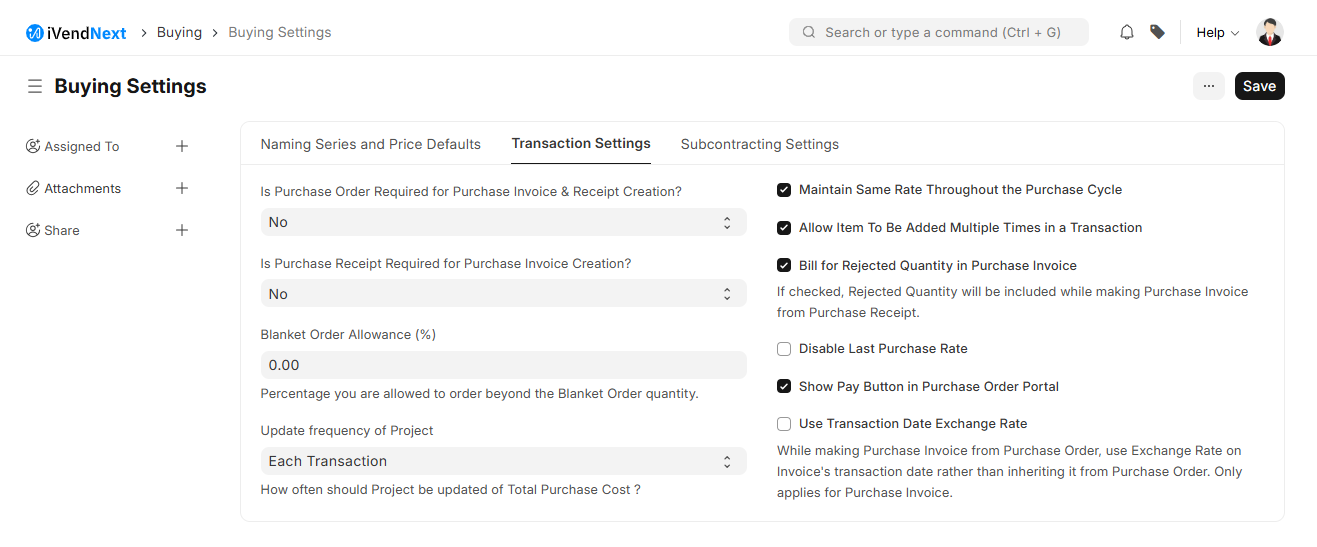Buying Settings
Buying Settings is where you can define properties which will be applied in the Buying module's transactions.
You can find Buying Settings at: Home > Buying > Settings > Buying Settings
The Buying Settings are split across the following tabs:
Naming Series and Price Details
Transaction Settings
Subcontracting Settings
Let us look at the various settings under each tab that can be configured:
Naming Series and Price Details
The important settings under the Naming Series and the Price Details Tab are explained below:
Supplier Naming By
When a Supplier is saved, the system generates a unique identity or name for that Supplier which can be used to refer to the Supplier in various Buying transactions.
If not configured otherwise, iVendNext uses the Supplier's Name as the unique name. If you want to identify Suppliers using names like SUPP-00001, SUPP-00002, or such other patterned series, select the value of Supplier Naming By as "Naming Series". You can define or select the Naming Series pattern from: Settings > Data > Naming Series. Read the article on Naming Series to know more about defining a Naming Series.
Default Supplier Group
Configure what should be the default value of Supplier Group when creating a new Supplier. For example, if most of your suppliers supply you hardware, you can set the default as 'Hardware'.
Default Buying Price List
Configure what should be the default Price List when creating a new Buying transaction, the default is set as 'Standard Buying'. Item prices will be fetched from this Price List. You can modify the 'Price List' by using the arrow at the right-end of the field to change the currency and country.
Transaction Settings
The important settings under the Transaction Settings Tab are explained below:
Purchase Order Required
If this option is configured "Yes", iVendNext will prevent you from creating a Purchase Invoice or a Purchase Receipt directly without creating a Purchase Order first. If retail transactions are involved where the order happens offline, then Purchase Orders can be skipped. If you're accepting sample Items, you can directly create a Purchase Receipt to receive the Items to your Warehouse. This configuration can be overridden for a particular supplier by enabling the "Allow Purchase Invoice Creation Without Purchase Order" checkbox in supplier master
Purchase Receipt Required
If this option is configured "Yes", iVendNext will prevent you from creating a Purchase Invoice without creating a Purchase Receipt first. In case the Item being transacted is a service, it'll not require a receipt, you can directly create an Invoice.
This configuration can be overridden for a particular supplier by enabling the "Allow Purchase Invoice Creation Without Purchase Receipt" checkbox in the supplier master
Maintain Same Rate Throughout Purchase Cycle
If this is enabled, iVendNext will validate whether an Item's price is changing in a Purchase Invoice or Purchase Receipt created from a Purchase Order, i.e. it will help you maintain the same rate throughout the purchase cycle.
You can configure the action that system should take if the same rate is not maintained in the "Action If Same Rate is Not Maintained" field:
Stop: iVendNext will stop you from changing the price by throwing a validation error.
Warn: The system will let you save the transaction but warn you with a message if the rate is changed.
Note: This field will only be visible if Maintain Same Rate Throughout Purchase Cycle is enabled.
Subcontracting Settings
The important settings under the Subcontracting Tab are explained below:
Set Landed Cost Based on Purchase Invoice Rate
If the purchase receipt rate and purchase invoice rate are not the same and users want to set the landed cost as per the purchase invoice then this feature will be useful.
Use Case
Created Purchase Receipt for item A with rate as 100
System has booked Stock In Hand with 100 rate
After 2 days, user has created purchase invoice against the above purchase receipt
After 2 days because of change in exchange rate the rate in the invoice changed to 150
Now purchase receipt has rate 100 where as Purchase invoice has rate 150
If you want to adjust the Stock In Hand with Purchase invoice Rate (150) then this feature will be helpful
Allow Item to be added multiple times in a transaction
When this checkbox is unchecked, an item cannot be added multiple times in the same Purchase Order. However, you can still explicitly change the quantity. This is a validation checkbox for preventing accidental purchase of the same item. This can be checked for specific use cases where there are multiple sources for the same material, for example in manufacturing.

